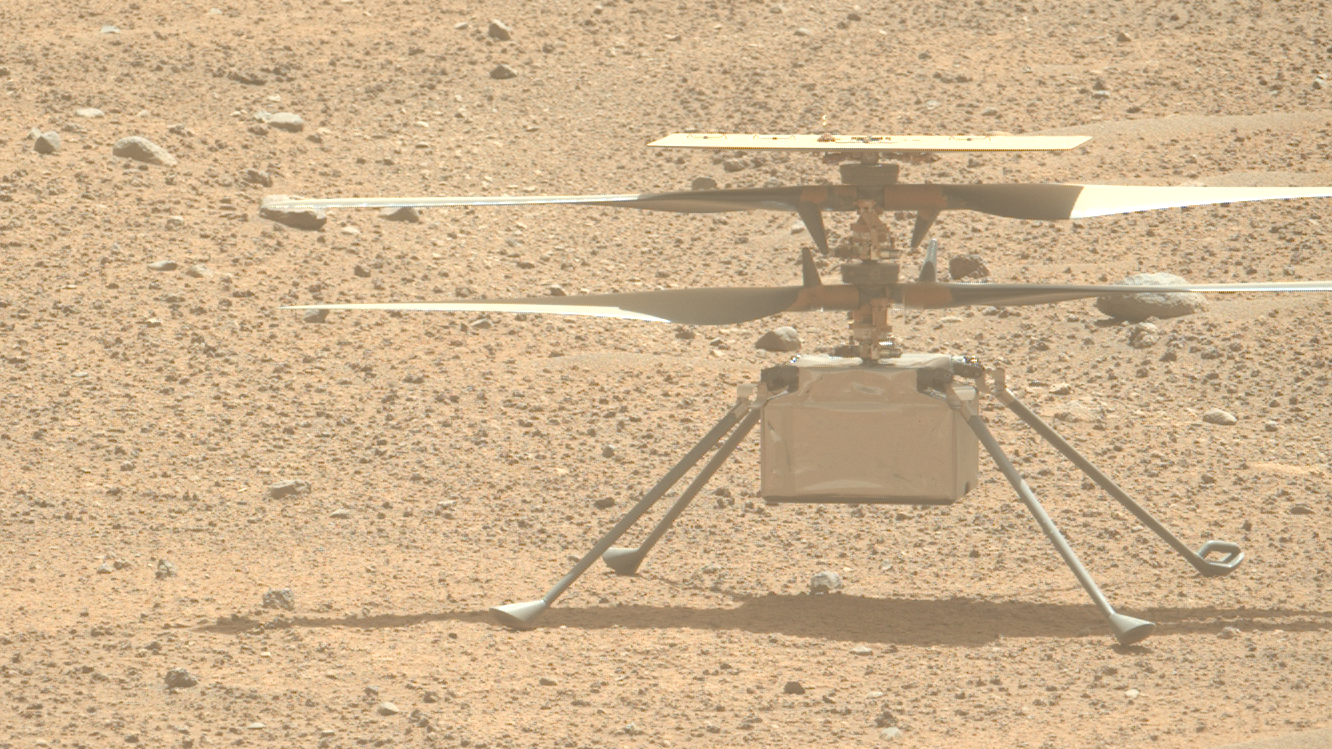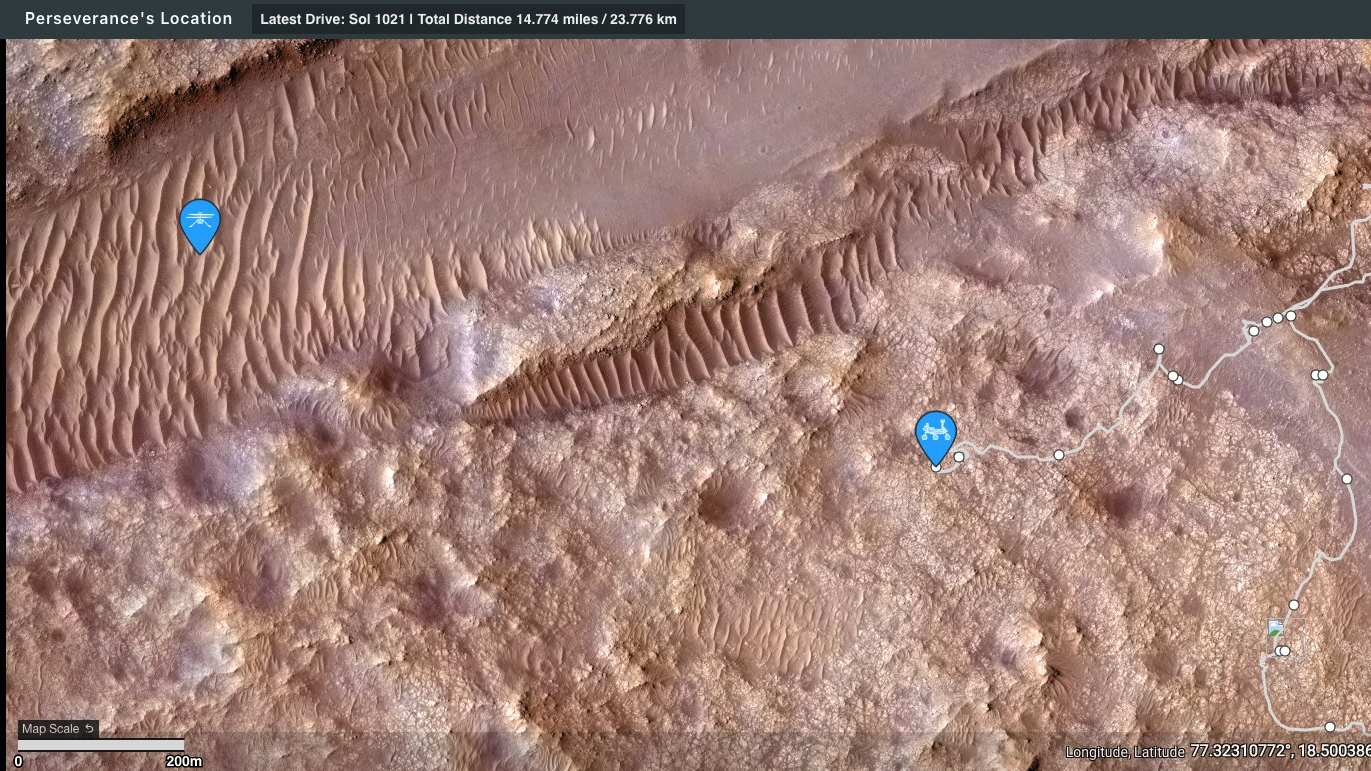
Update for 11:30 a.m. EST on Jan. 21: NASA announced on Saturday evening (Jan. 20) that it has reestablished contact with Ingenuity after instructing the Perseverance rover "to perform long-duration listening sessions for Ingenuity’s signal." The mission team is working to determine what caused the communications dropout during Flight 72.
NASA's Ingenuity Mars helicopter has gone incommunicado.
Ingenuity's handlers lost contact with the 4-pound (1.8 kilograms) chopper on Thursday (Jan. 18), toward the end of its 72nd flight on Mars.
"Data Ingenuity sent to the Perseverance rover (which acts as a relay between the helicopter and Earth) during the flight indicates it successfully climbed to its assigned maximum altitude of 40 feet (12 meters)," NASA officials wrote in an update on Friday (Jan. 19).
"During its planned descent, communications between the helicopter and rover terminated early, prior to touchdown," they added. "The Ingenuity team is analyzing available data and considering next steps to reestablish communications with the helicopter."
Related: Mars helicopter Ingenuity phones home, breaking 63-day silence
Ingenuity and Perseverance landed together in February 2021 on the floor of the 28-mile-wide (45 kilometers) Jezero Crater, which harbored a big lake and a river delta billions of years ago.
Get the Space.com Newsletter
Breaking space news, the latest updates on rocket launches, skywatching events and more!
Perseverance is hunting for evidence of past Mars life and collecting samples for future return to Earth. Ingenuity is serving as a scout for the car-sized rover, on an extended mission that NASA granted after the little chopper aced its original five-flight technology-demonstrating campaign in the spring of 2021.
It might be time for Perseverance to return the favor and help its little robotic cousin out.
"Perseverance is currently out of line-of-sight with Ingenuity, but the team could consider driving closer for a visual inspection," NASA's Jet Propulsion Laboratory in Southern California, which manages both robots' missions, said via X on Friday.

Ingenuity has stayed aloft for more than 128 minutes and covered a total of 11 miles (17.7 kilometers) during its 72 Mars flights, according to the mission's flight log.
It's unclear at the moment if those numbers will continue to go up. We'll have to wait and see if Ingenuity's handlers can get back in touch with the pioneering chopper, the first vehicle ever to explore the skies of a world beyond Earth.
Join our Space Forums to keep talking space on the latest missions, night sky and more! And if you have a news tip, correction or comment, let us know at: community@space.com.

Michael Wall is a Senior Space Writer with Space.com and joined the team in 2010. He primarily covers exoplanets, spaceflight and military space, but has been known to dabble in the space art beat. His book about the search for alien life, "Out There," was published on Nov. 13, 2018. Before becoming a science writer, Michael worked as a herpetologist and wildlife biologist. He has a Ph.D. in evolutionary biology from the University of Sydney, Australia, a bachelor's degree from the University of Arizona, and a graduate certificate in science writing from the University of California, Santa Cruz. To find out what his latest project is, you can follow Michael on Twitter.
-
pdjk Reply
The Ingenuity Mars helicopter is a fantastic achievement and will clearly influence all subsequent Mars exploration.Admin said:NASA lost contact with its Ingenuity Mars helicopter on Thursday (Jan. 18), toward the end of the little rotorcraft's 72nd Red Planet flight.
NASA loses contact with Ingenuity Mars helicopter : Read more
However contrary to the claim made in this article, Ingenuity is not 'the first vehicle ever to explore the skies of a world beyond Earth'.
In June 1985 the twin Soviet Vega probes deployed balloons into the atmosphere of Venus during their decent to the surface.
Although the Vega 1 lander's science package got triggered early by storms in the atmosphere during decent, both balloons operated successfully for over 46hrs where they conducted a variety of atmospheric measurements.
At this time Soviet space exploration was probably at its pinnacle, the French CNES coordinated international efforts to receive signals from the 2 balloons, including the support by the NASA deep space network.
There is a model of the balloons at the Smithsonian Air and Space Udvar-Hazy Center. -
MikeMc Wow, so averaging less than 2 minutes per flight. Hopefully, now that they know the technology works, they can design a better helicopter for the next rover, if there is one. Actually, a drone helicopter would also be very helpful to an astronaut mission to Mars. I’m sure a good sized helicopter could fit inside Starship. Starship should be ready for Mars in 8-10 years. I think they said that they would want around 100 flights without people aboard, first, just to be on the safe side.Reply









